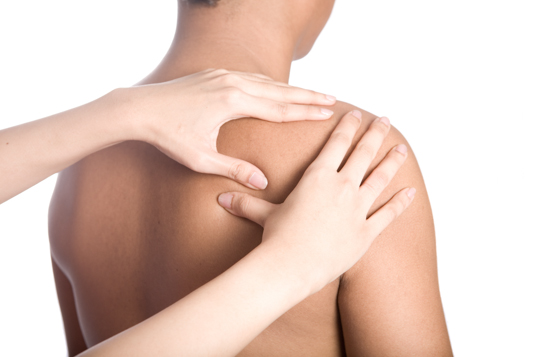Acupressure (a blend of “acupuncture” and “pressure”) is a complementary medicine technique derived from acupuncture. In acupressure physical pressure is applied to acupuncture points by the hand, elbow, or with various devices.
Traditional Chinese medicine’s (TCM) acupuncture theory predates use of the scientific method, and has received various criticisms based on scientific thinking. The anatomical or histological basis of acupuncture points or meridians, if they actually exist, is unknown.
Acupuncturists tend to perceive TCM concepts in functional rather than structural terms, i.e. as being useful in guiding evaluation and care of patients.
Neuroimaging research suggests that certain acupuncture points have distinct effects that are not otherwise predictable anatomically.
Background
Acupoints used in treatment may or may not be in the same area of the body as the targeted symptom.
The TCM theory for the selection of such points and their effectiveness is that they work by stimulating the meridian system to bring about relief by rebalancing yin, yang and qi (also spelled “chi”). This theory is based on the paradigm of TCM .
Many East Asian martial arts also make extensive study and use of acupressure for self-defense and health purposes (chin na, tui na). The points or combinations of points are said to be used to manipulate or incapacitate an opponent.
Also, martial artists regularly massage their own acupressure points in routines to remove blockages from their own meridians, claiming to thereby enhance their circulation and flexibility and keeping the points “soft” or less vulnerable to an attack.
A preliminary randomized trial of Tapas Acupressure Technique (TAT) found a possible weak correlation with weight loss maintenance using TAT versus Qigong or self-directed support, suggesting that TAT might outperform the other methods studied.
The results were not statistically significant, but a separation test indicated that further study is warranted. A full randomized trial of TAT versus standard weight loss management intervention is currently being conducted, funded by the NCCAM.
An acupressure wristband that is claimed to relieve the symptoms of motion sickness and other forms of nausea is available. The band is designed to provide pressure to the P6 acupuncture point, a point that has been extensively investigated.
The Cochrane Collaboration, a group of evidence-based medicine (EBM) reviewers, reviewed the use of P6 for nausea and vomiting, and found it to be effective for reducing postoperative nausea, but not vomiting.
The Cochrane review included various means of stimulating P6, including acupuncture, electroacupuncture, transcutaneous nerve stimulation, laser stimulation, acustimulation device and acupressure; it did not comment on whether one or more forms of stimulation were more effective.
EBM reviewer Bandolier said that P6 in two studies showed 52% of patients with control having a success, compared with 75% with P6. One author of an article published in the Scientific Review of Alternative Medicine disagreed.]
A Cochrane Collaboration review found that massage provided some long-term benefit for low back pain, and said: It seems that acupressure or pressure point massage techniques provide more relief than classic (Swedish) massage, although more research is needed to confirm this.
According to the principles of TCM, qi flows through the body via 14 primary meridians or channels.
To strengthen the flow of qi,or remove blockages in the meridians, an acupuncturist inserts a number of tiny, sterile, flexible needles just under the skin at certain specific points (called acupoints) along the channels.
There are four to five hundred named acupoints along the meridians, some of which are associated with specific internal organs or organ systems.
If you are suffering from nausea, for example, needles might be inserted into acupoints on your wrist, while a vision problem might be treated with needles in the foot.
(Additional ear, scalp, and hand points are also commonly used by some practitioners.) Acupuncture practitioners believe that the therapy stimulates the body’s internal regulatory system and nurtures a natural healing response.
A variant system known as two point acupressure attempts to bypass a blockage of vital flow by using one acupoint to create a link with one of the collateral meridians, and then using one additional acupoint to stimulate or reduce the flow around the obstruction.
Clinical use of acupressure frequently relies on the conceptual framework of Traditional Chinese Medicine (TCM), which some scholars have characterized as pseudoscientific.
There is no physically verifiable anatomical or histological basis for the existence of acupuncture points or meridians.
Proponents reply that TCM is a prescientific system that continues to have practical relevance. Acupuncturists tend to perceive TCM concepts in functional rather than structural terms (e.g., as being useful in guiding evaluation and care of patients).
There are several different instruments for applying nonspecific pressure by rubbing or rolling against the body. The acuball is a small ball made of rubber with protuberances that is heatable. It is used to apply pressure and relieve muscle and joint pain.
The energy roller is a small cylinder with protuberances. It is held between the hands and rolled back and forth to apply acupressure. The foot roller (also “krupa chakra”) is a round, cylindrical roller with protuberances.
It is placed on the floor and the foot is rolled back and forth over it. The power mat (also pyramid mat) is a mat with small pyramid-shaped bumps that you walk on.
The spine roller is a bumpy roller containing magnets that is rolled up and down the spine.
The Teishin is one of the original nine classical acupuncture needles described in the original texts of acupuncture.
Even though it is described as an acupuncture needle it did not pierce the skin. It is used to apply rapid percussion pressure to the points being treated.






